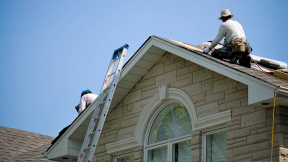Home maintenance checklist for homeowners

Quick insights
- Regular home maintenance is vital for preventing costly repairs and helping to ensure your home stays in top condition.
- A well-organized checklist helps homeowners stay on track with routine tasks, from seasonal inspections to appliance upkeep.
- Proactive maintenance not only preserves your home’s value but also could help boost energy efficiency and overall comfort.
As a homeowner, it can be easy to get caught up in the excitement of decorating, renovating or simply enjoying your new space. But there’s one thing that often gets overlooked–regular maintenance. Just like your car needs routine oil changes to keep running smoothly, your home requires consistent care to stay in top shape. Whether you’re a first-time homebuyer or a seasoned pro, having a maintenance checklist can help you stay organized and proactive.
The benefits of regular home maintenance
By staying on top of routine tasks like cleaning your gutters, inspecting the roof and servicing HVAC systems, you may prevent costly repairs and extend the lifespan of key systems. Proper maintenance might also boost property value, improve energy efficiency and give you peace of mind.
How much to budget for home maintenance
Budgeting for home maintenance on a regular basis may avoid unexpected financial burdens. It could be very helpful someday to have money set aside for the costs of repairs, replacements and seasonal upkeep.
- Guidelines for setting aside funds: A common rule is to save 1% or 3% of your home’s value per year for maintenance and repairs. For example, if your home is worth $300,000, aim to set aside $3,000 to $9,000 annually.
- Factors to consider: The age of the home, condition of your appliances and complexity of the systems in your home can affect how much you need to budget. For example, if a system is nearing the end of its useful life, you may need to budget extra for a replacement.
- Common maintenance costs: This could include painting the exterior, roof repair, HVAC maintenance and plumbing issues.
- Update your budget: Track expenses, anticipate future needs, account for both small, routine tasks and larger repairs. If you find that you had saved enough to pay for maintenance one year, you might decrease the amount you set aside for the next year.
- Benefits of an emergency fund: An emergency fund ensures you’re not caught off guard by significant, unplanned home expenses, such as broken water heater or urgent roof leak.
Monthly home maintenance checklist
- Check HVAC filters: Inspect and replace dirty air filters to improve air quality. Depending on the size of your filter, maybe you only need to replace it every two, three or six months.
- Inspect plumbing: Look for leaks under sinks, around toilets and near appliances like washing machines or dishwashers. Water damage can accumulate fast and should be addressed promptly.
- Test smoke and carbon monoxide detectors: Ensure all detectors are functioning properly by pressing the test button. Replace batteries if needed.
- Examine gutters and downspouts: Check for clogs or debris, especially after heavy rains. Clear any blockages to prevent water damage.
- Clean kitchen range hood and vents: Remove grease buildup from filters to maintain proper ventilation and fire safety.
- Inspect windows and doors: Check for drafts, cracks or broken seals that could impact energy efficiency.
- Flush drains: Run hot water and vinegar through drains to prevent clogs and maintain flow.
- Inspect exterior lighting: Check outdoor lights for burnt-out bulbs or damage ensuring safety and security.
- Examine outdoor areas: Check decks, patios and fencing for wear or damage and repair as needed.
Summer home maintenance checklist
- Clean or replace air filters and consider professional HVAC service.
- Clean outdoor grills and ensure propane tanks or gas lines are in good condition.
- Check for loose boards, cracks or peeling paint; reseal if necessary.
- Dust and reverse fan direction to ensure proper airflow for cooling.
- Check hoses, sprinklers and spigots for leaks or clogs.
- Look for loose shingles or signs of wear, especially after storms.
Fall home maintenance checklist
- Remove fallen leaves and debris to prevent water damage.
- Check for damaged shingles and ensure the chimney is free of obstructions or creosote buildup.
- Apply weatherstripping or caulking to prevent drafts and lower heating costs.
- Apply fall fertilizer to strengthen grass roots for the upcoming winter.
- Have your furnace or boiler inspected and replace filters.
- Clean and store patio furniture, umbrellas and grills to protect them from winter weather.
- Shut off water supply and draining systems before temperatures are regularly below freezing.
Winter home maintenance checklist
- Winterize your home by insulating exposed pipes and letting faucets drip during extreme cold to prevent bursting.
- Check attic and basement insulation to retain heat and prevent ice dams.
- Test fire and CO detection systems, ensuring functionality and replacing batteries as needed.
- Clean lint buildup in dryer vents, register vents and external vents to help avoid fire hazards.
- Ensure doors and windows are sealed tightly to keep out cold air.
- Regularly replace filters and have systems serviced if needed.
- Have snow shovels, salt and emergency kits ready for storms.
Spring home maintenance checklist
- Check for damage from winter storms and clean gutters to prepare for spring rains.
- Look for signs of leaks or dampness in basements, attics and around windows.
- Wash windows and repair or replace torn screens.
- Look for cracks in driveways, sidewalks or patios and schedule repairs.
- Prune shrubs. Aerate the lawn and add mulch to garden beds.
- Plant grass seed or fertilize, depending on what your lawn needs.
Annual home maintenance checklist
- Schedule a professional roof inspection: Identify and address potential leaks, missing shingles or structural issues.
- Service the HVAC system: Have a technician perform a thorough inspection of both heating and cooling systems to ensure efficiency and longevity. You may want to do this several times a year depending on your setup.
- Inspect the water heater: Check for leaks, flush sediment from the tank and ensure the pressure relief valve is working.
- Examine foundation and exterior walls: Look for cracks, water pooling or signs of pests that could indicate structural concerns.
- Seal driveways and walkways: Apply sealant to prevent cracks from worsening and to protect against weather-related wear.
- Check for pest infestations: Inspect for termites, rodents, or other pests, particularly in basements, attics and crawl spaces.
- Inspect electrical systems: Have an electrician check the breaker box, outlets and wiring for signs of damage or wear.
- Assess attic ventilation and insulation: Ensure proper airflow and adequate insulation to reduce energy costs and prevent moisture buildup.
- Service garage doors: Lubricate moving parts, check for alignment issues and test the auto-reverse feature for safety.
- Test your home’s safety systems: Replace fire extinguisher tags, check security cameras and update emergency plans if needed.
In summary
Regular home maintenance protects (and sometimes boosts) the value of your investment. Maintenance can also improve comfort of your living space and prevent expenses repairs down the road. By staying proactive with routine tasks, you can possibly extend the lifespan of your property and even increase its value. Creating a maintenance schedule, conducting inspections and keeping accurate records are all helpful steps in ensuring your home remains a safe and comfortable place to live for years to come.



